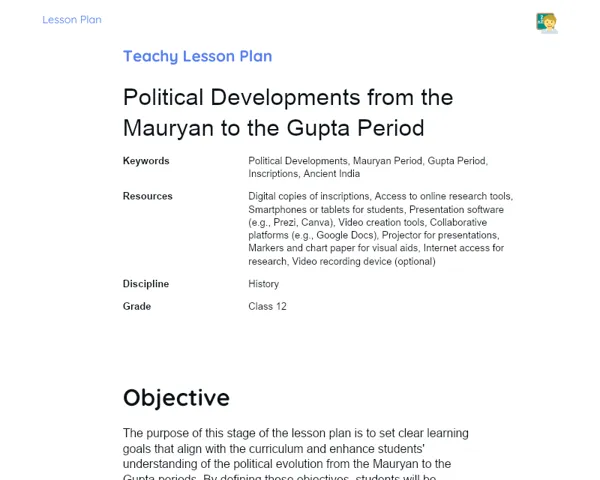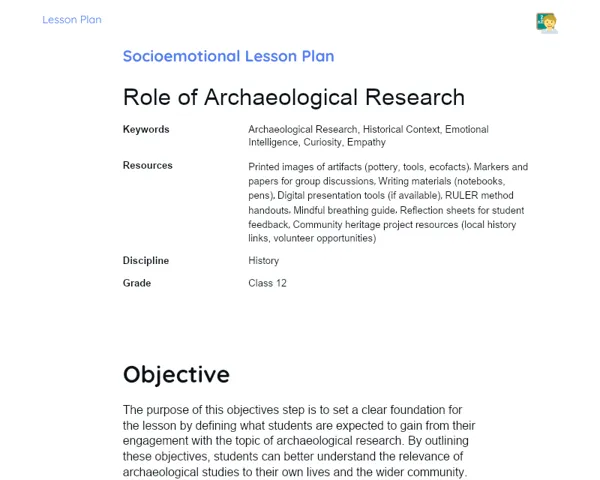Lesson Plan | Lesson Plan Iteratif Teachy | Ancient Rome: Introduction
| Keywords | Ancient Rome, History, 6th grade, Roman contributions, Digital Methodology, Interactive Activities, Gamification, Storytelling, Social Media, Research, Collaboration, Roman Architecture, Roman Law, Religion, Latin Language |
| Resources | Cell phones, Computers, Internet Access, Online Research Tools, Social Media Platforms (like Instagram), Image Editing Apps, Educational Gamification Platforms (Kahoot, Quizizz or Google Forms), Digital Newspaper Creation Tools (Google Docs, Canva or similar), Graphic Materials (images, illustrations), Support Materials (historical texts, explanatory videos) |
| Codes | - |
| Grade | 6th grade |
| Discipline | History |
Goal
Duration: 10 - 15 minutes
This stage aims to familiarize students with the core objectives of the lesson on Ancient Rome, framing them within the skills necessary for grasping the subject matter. The goal here is to ensure students are clear about what is expected from them and how they can achieve these learning outcomes, setting the stage for their active participation in the planned activities.
Goal Utama:
1. Understand the key features and periods of ancient Roman history.
2. Identify and analyze the contributions of Rome to the Western world, encompassing law, architecture, language, and religion.
Goal Sekunder:
- Enhance research and critical thinking skills through engaging digital tasks.
- Promote teamwork and communication among students via group discussions and collaborative digital projects.
Introduction
Duration: 15 - 20 minutes
This stage is designed to introduce students to the topic of Ancient Rome in a lively and meaningful manner, using digital resources that resonate with their everyday lives. By searching for information and engaging with peers, students activate their prior knowledge, nurture curiosity, and ignite the learning process collectively.
Warming Up
✨ Introduction to the Topic: Ancient Rome ✨
Ancient Rome stands as one of history's most captivating and influential civilizations, with its culture, politics, and achievements continuing to affect the modern world in countless ways. To kick things off, ask students to use their smartphones to discover an interesting fact about Ancient Rome. This might pertain to politics, architecture, or religion, among other topics. After that, have them share their discoveries with the class. This initial exercise is designed to ignite curiosity and establish a connection to the subject in a fun, interactive manner.
Initial Thoughts
1. 👑 What were the key contributions of the Romans to our modern world?
2. 🏛️ How has Roman architecture influenced the structures we see today?
3. ⚖️ What insights do you have about the Roman legal system and its importance?
4. 🗣️ How did the Latin language impact the evolution of modern languages?
5. 🙏 What was the role of religion within ancient Roman society?
Development
Duration: 70 - 80 minutes
This stage is designed to encourage students to deeply engage with Ancient Rome via practical and interactive tasks. Using technology and links to modern digital experiences, students will better grasp the contributions and historical significance of Ancient Rome while enhancing their skills in research, creativity, collaboration, and communication.
Activity Suggestions
Activity Recommendations
Activity 1 - 📱 Ancient Rome on Instagram: Roman Influencers
> Duration: 60 - 70 minutes
- Goal: Leverage storytelling and social media to explore and present historical figures from Ancient Rome in an engaging manner, fostering deeper understanding of the topic.
- Deskripsi Activity: Students will craft fictional Instagram profiles for notable figures from Ancient Rome. They will utilize images, videos, and posts to narrate the lives and contributions of these historical personalities. The goal is to use narrative techniques to delve into Roman culture and history creatively and interactively.
- Instructions:
-
Divide the class into groups of no more than 5 students.
-
Each group will select a Roman historical figure, such as Julius Caesar, Augustus, Cicero, or a symbolic character like a Roman soldier or matron.
-
Instruct students to use their phones and computers to research the lives and achievements of their chosen figures.
-
Each group will create a fictional Instagram profile for their selected character, using image editing applications to make engaging posts.
-
Posts should feature images (edited photos, illustrations, etc.), descriptive captions, and relevant hashtags that contextualize the individual within Ancient Rome.
-
Students should aim to create at least 5 posts that tell the story of their historical figure, highlighting key moments and contributions.
-
Finally, each group will present their profile to the class, detailing their choices and what insights they gained through the activity.
Activity 2 - 🎮 Gamification: Ancient Rome – Historical Mission
> Duration: 60 - 70 minutes
- Goal: Foster student engagement with Ancient Rome through gamification, promoting active participation, healthy competition, and enhanced retention of information.
- Deskripsi Activity: Students will be organized into groups to take part in a digital quiz game focused on Ancient Rome. Each correct answer allows groups to progress and unlock new insights about Roman civilization.
- Instructions:
-
Divide the class into groups of up to 5 students.
-
Each group must access a gamification platform suited for creating online quizzes and challenges (like Kahoot, Quizizz, or Google Forms).
-
Groups will design an avatar that represents a Roman citizen.
-
Prepare a quiz centering around Ancient Rome, covering topics like politics, architecture, religion, law, and language.
-
Each group will complete the quiz, and for every correct answer, they'll unlock new levels of challenges and additional information.
-
Finishing each level unlocks 'digital rewards' such as images of Roman artifacts, explanatory videos, or historical text excerpts.
-
At the end, the group with the highest score and who completes all levels will be crowned the winner and receive a digital 'badge' for their knowledge about Ancient Rome.
-
Wrap up the activity with a discussion about what they learned and how gamification shaped their understanding.
Activity 3 - 📰 Digital Newspaper of Ancient Rome
> Duration: 60 - 70 minutes
- Goal: Cultivate research, writing, and creativity skills through producing a digital newspaper that immerses students in Ancient Rome in an engaging and educational manner.
- Deskripsi Activity: Students will design a special edition of a digital newspaper as if they were living in Ancient Rome. They will author articles, reports, and fictitious interviews covering events, characters, and cultural elements of Rome.
- Instructions:
-
Divide the class into groups of no more than 5 students.
-
Each group will select a digital tool for newspaper creation, such as Google Docs, Canva, or another similar platform.
-
Guide students to research historical events, significant figures, and cultural and societal aspects of Ancient Rome.
-
Each group should create different sections for the newspaper, covering politics, society, culture, sports, and opinions.
-
Articles and reports must be crafted as if they were current news, utilizing language fitting for the audience of that time.
-
In addition to written content, students can incorporate images, illustrations, and imaginative 'ads' to enhance the realism and appeal of the newspaper.
-
Post completion, each group will present their newspaper to the class, showcasing the standout stories and describing their creative process.
-
Conclude the activity with a discussion on how various media and formats can enrich the comprehension of history.
Feedback
Duration: 20 - 25 minutes
This stage aims to foster in-depth reflection on learned content, promoting idea exchange and collaboration among students. Group discussions and 360° feedback allow students to assess their performances, acknowledge peers' contributions, and identify areas for enhancement, thereby strengthening their learning experience and developing social and communicative skills.
Group Discussion
🗣️ Group Discussion
Facilitate a group conversation among all students, allowing groups to share their learning experiences and conclusions. Use the following outline to initiate the discussion:
- Introduction: Kick off by inviting each group to provide a brief summary of their activities and findings.
- Sharing: Encourage each group to highlight one or two of the most intriguing or unexpected aspects they discovered about Ancient Rome.
- Collective Reflection: Motivate the class to reflect on how the digital approach contributed to their learning and identify what they found most challenging or rewarding.
- Conclusion: Wrap up by expressing gratitude for everyone's participation and underline the significance of teamwork and innovative technology use in learning.
Reflections
1. 💡 Reflection Questions
To steer the group discussion, consider these questions:
- How did the digital activities enhance your understanding of Roman history and culture?
- In what ways did learning about Ancient Rome through digital activities differ from traditional teaching methods?
- How did the incorporation of social media and gamification make the learning experience more engaging and relevant?
Feedback 360º
🔄 360° Feedback
Guide the teacher to conduct a 360° feedback round, ensuring every student receives feedback from their peers regarding the activity. Encourage a constructive and respectful environment by suggesting that students adopt the 'Praise, Improvement, Praise' model to deliver balanced and positive feedback. For instance: 'I loved how you shared creative ideas for our project. Perhaps next time, you could participate more actively in the research phase. But overall, you led our presentation exceptionally well.'
Conclusion
Duration: 10 - 15 minutes
🎯 Purpose of the Conclusion 🎯
This stage aims to solidify learning by highlighting the crucial points discussed and linking them to contemporary relevance. It’s an opportunity to reflect on how what we've studied continues to impact our lives. This conclusion also strives to inspire students to delve deeper into the topic, demonstrating its significance and applicability in today's world.
Summary
🎉 Fun Summary about Ancient Rome 🎉
Just picture living in a city populated with gladiators, awe-inspiring temples, and roads branching out in every direction! In Ancient Rome, leaders like Julius Caesar and Augustus transformed history with their daring decisions. We can't overlook the architectural marvels like the Colosseum, which continues to inspire modern constructions. The Latin language, legal frameworks, and even the pantheon of Roman gods have profoundly influenced our contemporary world. So, here’s a salute to Rome, where the annals of history meet monumental achievements!
World
🌍 Connection with the Modern World 🌍
The legacy of Ancient Rome remains vibrant and impactful today. Social media now functions like a modern Roman forum where ideas are debated and shared. Contemporary legal systems uphold principles rooted in Roman law, while our architecture frequently mirrors the grand arches and columns of ancient Rome. Additionally, a significant portion of our vocabulary across various modern languages has its origins in Latin. Therefore, understanding Ancient Rome is essential to grasping the very foundations of many frameworks and practices prevalent in our society today.
Applications
📚 Everyday Importance 📚
Grasping the significance of Ancient Rome offers valuable perspectives on the development of many institutions and customs that shape our daily routines. From the laws that govern us to the language we employ, Roman influence is ubiquitous. Exploring this civilization enhances our appreciation of this legacy and equips us with the tools to interpret and refine modern practices.



